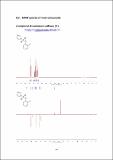Files in this item
Sequential processes using catalytic C-O bond activation
Item metadata
| dc.contributor.advisor | Clarke, Matt | |
| dc.contributor.author | Harkness, Gavin J. | |
| dc.coverage.spatial | xiii, 261, xiv-xv p. | en_US |
| dc.date.accessioned | 2018-02-27T16:41:30Z | |
| dc.date.available | 2018-02-27T16:41:30Z | |
| dc.date.issued | 2018-06-27 | |
| dc.identifier.uri | https://hdl.handle.net/10023/12809 | |
| dc.description.abstract | This thesis is centred around sequential C-C bond forming processes using oxygenated electrophiles. A major part of this research focuses on the constructive deoxygenation of 2-methoxyphenol (guaiacol), a major breakdown product of the renewable feedstock, lignin. 1,2-dielectrophiles are known to be challenging substrates for catalysis if both leaving groups are of similar reactivity, however high selectivity was observed in the palladium- catalysed Grignard cross-coupling of 2-methoxyphenyl-1H-imidazole-1-sulfonate. The previously untested Grignard cross-coupling catalyst, [PdCl₂(Xylyl-Phanephos)], was found to be highly active. A 2-benzoxazolyl functionality was shown to be an excellent directing group for the chelation-controlled nucleophilic aromatic substitution of aryl methyl ethers. However, this modified Meyers reaction is limited to aryl ethers containing an ortho-chelating group. To expand the ether scope, nickel-catalysed Grignard cross-coupling was studied. [NiCl₂(PⁿBu₃)2] showed increased activity in the Grignard cross-coupling of challenging ortho-substituted anisoles compared to the well-renowned [NiCl₂(PCy₃)2] and several Ni0 -NHC systems, with a ligand steric effect demonstrated. The success of [NiCl₂(PⁿBu₃)2] was extended to more activated methoxynaphthalene substrates, in which the lowest reported catalyst loadings (0.1-0.25 mol%) were reported. Induction periods at 0.1 mol% suggested the requirement of inorganic Lewis-acidic magnesium salts to be formed in situ before any considerable activity was observed. Further work is required to increase reaction and ether scope, but this work provides a basis for exploiting lignin- derived phenols as a framework in the synthesis of functionalised chemicals of higher value. The final results chapter concerns an alternative sequential C-C bond forming process using another oxygenated electrophile. [PdCl₂((S)-Xylyl-Phanephos)] was used to accomplish a Grignard cross-coupling of vinyl tosylate, with the product then subjected to a highly enantioselective methoxycarbonylation using the same catalyst. This lead to a concise synthesis of (S)-Flurbiprofen. | en |
| dc.language.iso | en | en_US |
| dc.publisher | University of St Andrews | |
| dc.subject | Catalysis | en |
| dc.subject | Cross-coupling | en |
| dc.subject | Constructive deoxygenation | en |
| dc.subject | C-O bond activation | en |
| dc.subject | Carbonylation | en |
| dc.subject | Flurbiprofen | en |
| dc.subject.lcsh | Catalysis | en |
| dc.subject.lcsh | Chemical bonds | en |
| dc.subject.lcsh | Flurbiprofen | en |
| dc.title | Sequential processes using catalytic C-O bond activation | en_US |
| dc.type | Thesis | en_US |
| dc.contributor.sponsor | Engineering and Physical Sciences Research Council (EPSRC) | en_US |
| dc.contributor.sponsor | University of St Andrews. School of Chemistry | en_US |
| dc.type.qualificationlevel | Doctoral | en_US |
| dc.type.qualificationname | PhD Doctor of Philosophy | en_US |
| dc.publisher.institution | The University of St Andrews | en_US |
| dc.identifier.doi | https://doi.org/10.17630/10023-12809 |
This item appears in the following Collection(s)
Items in the St Andrews Research Repository are protected by copyright, with all rights reserved, unless otherwise indicated.


